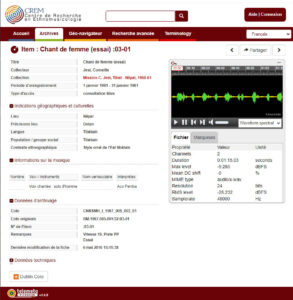Corneille JEST Collection (1930-2019)
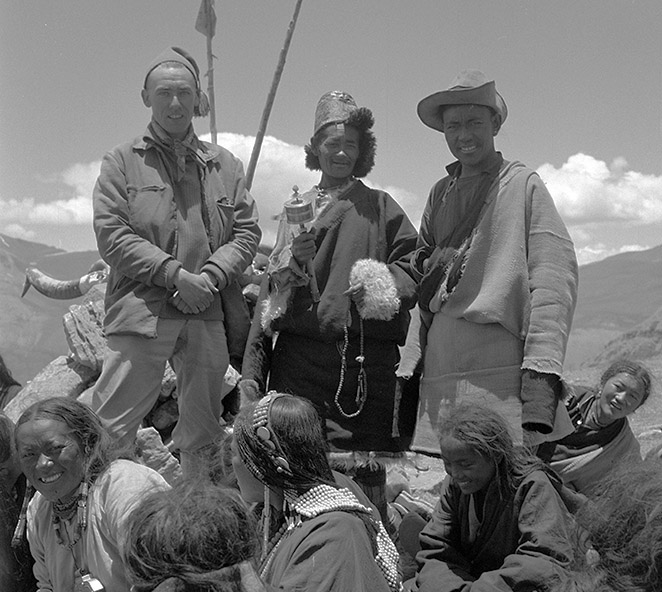
Corneille Jest, Dolpo, 1960
Biography
by Fernand Meyer
Born in Strasbourg on February 12, 1930, the only son of an engineer father and a housewife mother, Corneille Jest spent his childhood in his village of Souffelweiersheim, which was still largely agricultural at the time. Throughout his life, he maintained close ties with his native environment and his Alsatian identity, as his career opened up ever wider and richer horizons.
In 1930, when the inhabitants of Alsace and Moselle were evacuated in anticipation of the advancing troops of the Third Reich, and his father had been enlisted in the French army, C. Jest, accompanied by his mother and grandmother, was welcomed in Millau, Aveyron, by the family of M. Artières, with whom Corneille’s father had professional ties. It was in Millau that Corneille continued his studies up to the second year of high school.
His father, demobilized from the French army after the armistice, came to join his family and was assigned to the Aveyron civil engineers. He was later interned in the Neuengamme camp in Germany for acts of resistance, and the entire Jest family was not reunited in Alsace until 1945.
In Millau, C. Jest had found in Simone, one of M. Artières’ daughters, a childhood friend with whom he kept in touch, and who would later become his wife.
After passing his baccalauréat in Strasbourg, he began by studying natural sciences for the Certificat d’études supérieures préparatoires en sciences physiques, chimiques et naturelles (SPCN), but his studies were interrupted by health problems that necessitated long stays in a preventorium. At this juncture he chooses to turn towards studies in human and social sciences in Strasbourg where he got his batchelor degree, and was then encouraged to continue his studies in Paris with Professor André Leroi-Gourhan in 1953.
That same year, his parents’ connections with a Swiss missionary of the Canons Regular of Saint-Maurice stationed in the Kalimpong district of the Apostolic Prefecture of Sikkim allowed him to make his first trip to Asia, financed by his father. This was his first field experience in what had been a former territory of the kingdom of Sikkim, where he encountered not only Tibetan culture but also the indigenous Lepcha people, in whom he seems to have taken a particular interest. A year later (1954), he published a series of photos entitled “Visages Lepchas”, in issue 6 of the journal Sciences & Nature, sponsored by the Muséum d’Histoire Naturelle, followed by an article entitled “Religious Beliefs of the Lepchas in the Kalimpong District (West Bengal)” in the Journal of the Royal Asiatic Society, vol 92, N°3-4, 1960.
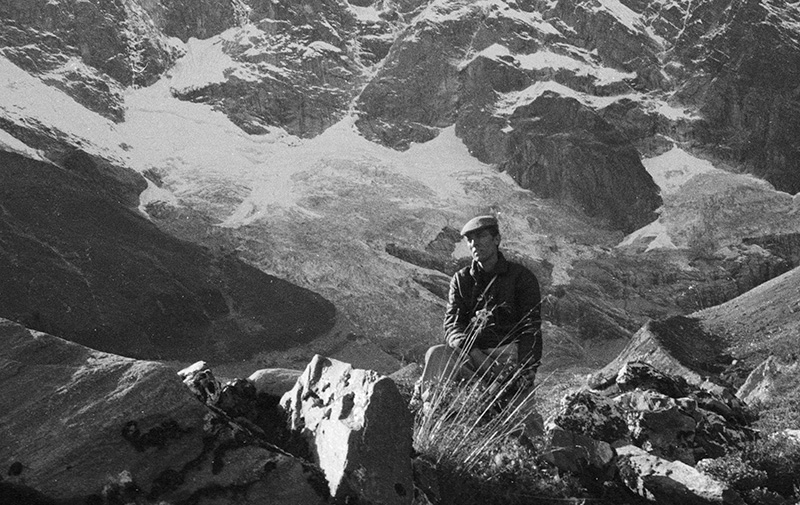
Corneille Jest in the Himalayas, 1969.
So it was from the start of the 1953 academic year that C. Jest began attending the Centre de formation aux recherches ethnologiques (CFRE), founded by A. Leroi-Gourhan in 1946, and chaired by him at the Musée de l’Homme, Paris. At the time, the course was unique in that it included an eight-week fieldwork traineeship in France, and had been attached to the French National Center for Scientific Research (CNRS) since 1948. The courses taught at the Musée de l’Homme were moreover closely associated with those of the Institut d’ethnologie de l’Université de Paris, which had been founded in 1922 by M. Mauss, P. Rivet and L. Lévy-Brühl.
André Leroi-Gourhan (1911-1986), prehistorian and anthropologist, distinguished himself in the field of human and social studies, notably through the importance he attached to a multidisciplinary approach to human communities, past and present, from the privileged angle of their material culture, anthropology of techniques, which led him to be involved in several museums, most notably the Musée de l’Homme. This type of approach was to mark, to varying degrees, the rest of C. Jest’s professional career.
In 1954, while France was engaged in the Algerian war, he was called up for military service in the French Navy. After passing through Brest and Toulon, he was posted to the Khoribga military base in Morocco, where his wife Simone joined him after their marriage the following year. In 1956, while he was still in the army, A. Leroi-Gourhan informed him that he could propose him for a trainee post at the CNRS. If he agreed, the application would require the choice of a research field. The supervisor suggested that the future candidate choose Asia rather than Africa, where, in his opinion, there was already a plethora of researchers. Because of his taste for mountains and no doubt his first field experience in Sikkim, C. Jest opted for Nepal, which had just opened to foreigners in 1951.
It was only after completing his military service, in 1957, that he returned to France with his wife and re-entered the academic and museological world of French anthropology. He was soon appointed a researcher at the CNRS, where he spent the rest of his professional career.
From 1957 to 1959, C. Jest also studied with Claude Lévi-Strauss at the École Pratique des Hautes Études. His intellectual career and subsequent work, however, were not marked by the structuralism that was increasingly in vogue in anthropology at the time. Instead, his career continued in the wake of some of the aspects promoted by A. Leroi-Gourhan’s approach. C. Jest maintained close links with the Musée de l’Homme, then directed by Prof. Jacques Millot, a physician, naturalist and anthropologist. C. Jest was also in charge of the Centre de formation à la recherche ethnologique, under the direction of A. Leroi-Gourhan.
In 1959, he strengthened his collaboration with Jean-Dominique Lajoux, ethnologist photographer and film-maker. Over the years, this collaboration led to several films, shot first in Aveyron (C. Jest’s post-graduate thesis: “Le Haut-Levezou: techniques et économie d’une communauté rurale”, Sorbonne 1960), then more widely in Aubrac (southern Massif Central of France), and in Nepal in the following decades.

Corneille Jest and Charles Parain working for RCP Aubrac, 1964. source: MUCEM
For C. Jest, the early sixties marked a period of intense fieldwork between Nepal and France (Aubrac program).
The discovery of his first fieldwork site in Nepal, in the Tibetan culture region of Dolpo, which was still very difficult to access at the time, and which was to fuel his research for the State Doctorate (1972) for several years, owed much to David Snellgrove, then Professor of Tibetan Studies at the School of Oriental and African Studies (SOAS) in London.
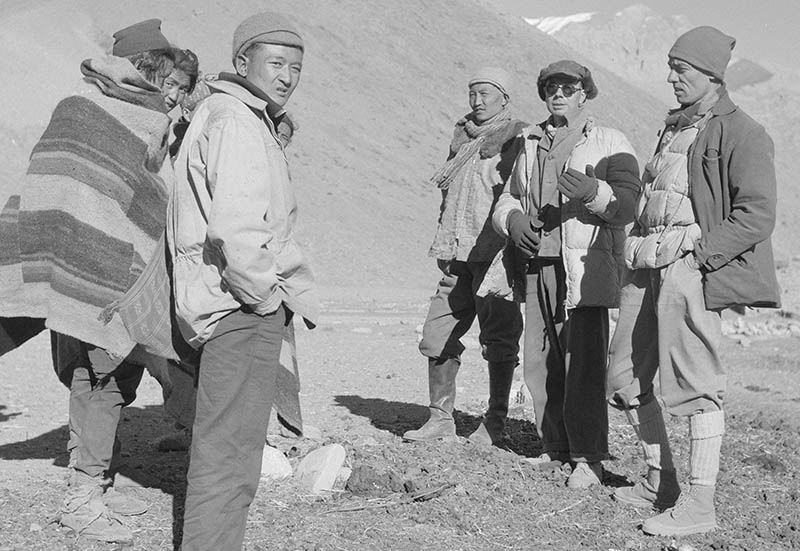
Corneille Jest, David Snellgrove and Pasang Sherpa, Dolpo, 1960.
In the summer of 1960, C. Jest traveled to Dolpo, where he was introduced by D. Snellgrove, and established his survey base in the village of Tarap. After this initial eleven-month stay, assisted by D. Snellgrove’s collaborator Pasang Sherpa, he regularly returned there in 1963, 1965 and 1967 for shorter stays and further research.
During these same years, C. Jest actively campaigned for the creation of a multidisciplinary structure dedicated to research in Nepal in France. This was achieved in 1965 with the creation of the “Étude des régions népalaises” team (RCP 65) within the framework of Cooperative Researches on Program (RCP) recently set up by the CNRS. He led this team, initially comprising mainly ethnologists, as mission leader under the statutory responsibility of Prof. Jacques Millot. Very early on, he insisted that the group should set up a documentation center on the Himalayan regions. Enriched by purchases and documentation brought back from the field by researchers over the years, this center would become one of the most important in the field.
Alongside these developments concerning French research in Nepal, C. Jest, who was then in charge of the Centre de Formation à la Recherche Ethnologique (CFRE) at the Musée de l’Homme under the direction of A. Leroi-Gourhan, interested the latter in the formula of Cooperative Researches on Program (RCP) for setting up such a research project in France, associating human and social sciences, life sciences, economics and agronomy, the production of knowledge also opening up prospects for development. C. Jest, who knew the region well, suggested Aubrac, where a major collective program was carried out from 1964 to 1966.
For him, this cross-disciplinary look at a well-defined and coherent geographical, economic, sociological and cultural area, then undergoing major changes from tradition to modernity, open to possible development projects, remained a model from which he drew inspiration for various collective projects he was to initiate in Nepal in the following decades.
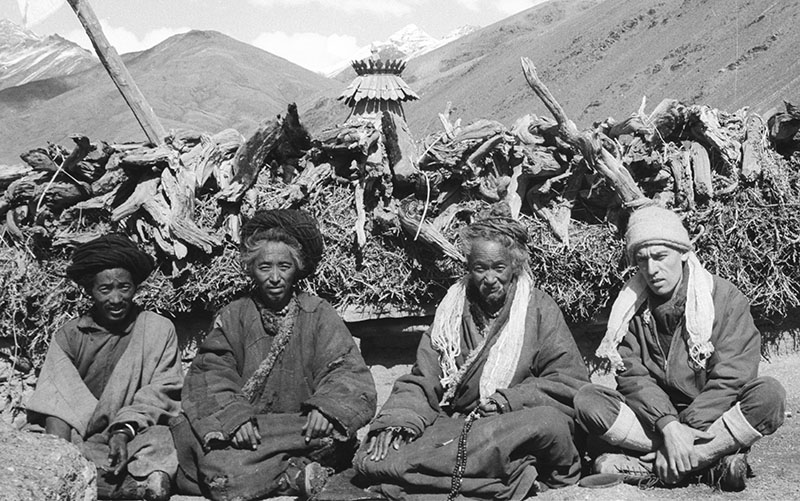
Corneille Jest and Gakar Rinpoche, Tarap, 1965.
In 1970, under the direction of C. Jest, the former RCP Nepal was replaced by a new team, “Ecologie et géologie de l’Himalaya central” (RCP 253), extending its scope beyond Nepal to the Himalayas, and its disciplinary field to include biological anthropology, geography, geology, ecology, and agronomy.
These early formations were subsequently taken over by the Groupement de recherche sur programme (GRECO) “Himalaya-Karakorum” (1976-1990), then, from 1985, by the Unité recherche propre (UPR 299) “Milieu, sociétés et cultures en Himalaya” renamed “Centre d’Études Himalayennes” in 2010.
In these various structures, and even when he no longer exercised a management function, C. Jest played an important driving role as an inspirer and animator of research, both individual and collective, until his retirement in 1997.
In 1980, along with other researchers from various disciplines, including Patrick Le Fort, Michel Colchen, and Jean-François Dobremez, he took part in the Symposium on the Tibetan Plateau, organized by the Chinese Academy of Sciences in Beijing (May 26-30), followed by the first visit of foreign researchers to the Tibet Autonomous Region (June 1-14).
The following features marked C. Jest’s career:
– His very broad vision of the research field, enabled him to enter into productive dialogue with researchers in academic disciplines other than his own.
– His taste for in-depth fieldwork, as evidenced by the wealth of documentation and wide-ranging interests in his field notebooks, and for collective projects combining the contributions of various disciplines.
– His natural and spontaneous empathy with all his local interlocutors, informants, collaborators, colleagues, and institutions, facilitated by his fluency in Nepali and Tibetan. The confident understanding he maintained during his whole career with his Nepali assistant Sarkiman Majhi, inviting him to stay with his family in France, bears testimony to the quality of those relations.
– The importance he attached to building up a rich collection of shared documentary resources (written and figurative sources collected in the field, photographs and films, audio recordings, maps, etc.), as well as to collecting objects in the field (herbarium deposited at the Paris Natural History Museum, large collection of objects now kept at the Musée du Quai Branly – Jacques Chirac).
– His interest in the material techniques of production and everyday life.
– His openness to research into issues of economic development and heritage conservation and enhancement (including his role as a consultant to UNESCO), aiming to transfer research findings to local communities.
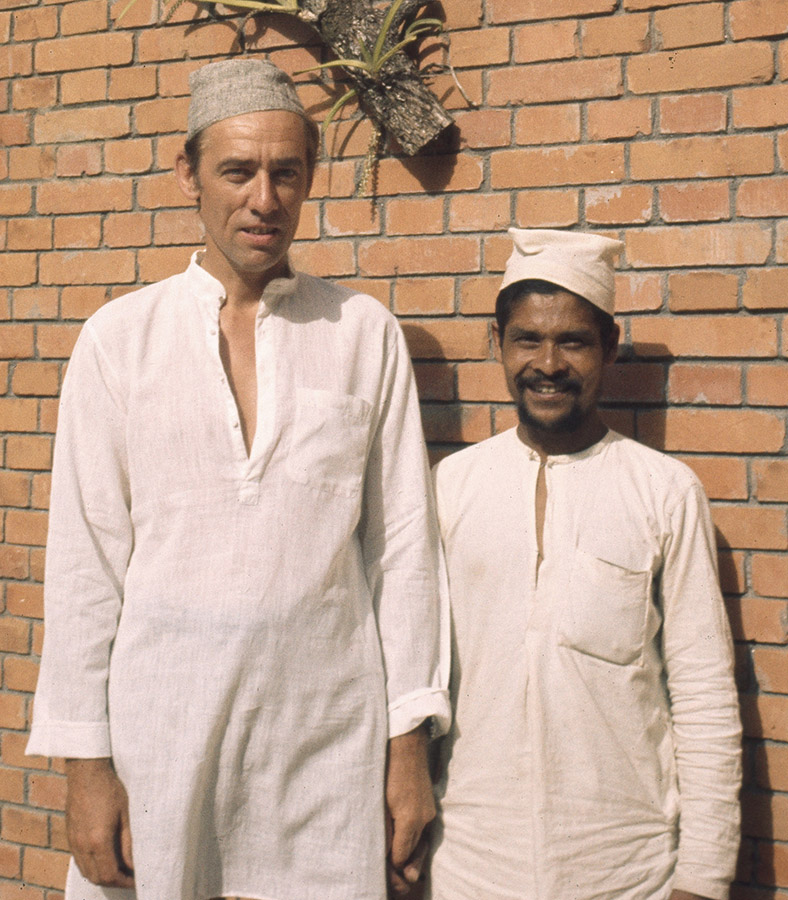
Corneille Jest and Sarkiman Majhi, Kathmandu, 1975.
In addition to his rich field notebooks, C. Jest has left us a huge collection of photographs, whose documentary value is often enhanced by their striking aesthetic qualities, which made his book Tarap: Une vallée dans l’Himalaya, published by Seuil in 1974, a public success.
From the early 1960s until after his retirement, hardly a year passed without C. Jest undertaking one or two missions to the Himalayas. Among Nepal’s specialists, he is certainly one of those who traveled most extensively in its various regions. However, his research interests and various expertise, for which he has been called upon by international organizations (UNESCO, UNDP, Getty Foundation…), have led him to work more widely in Asia: Ladakh, Bhutan, Tibet Autonomous Region, Pakistan, Mongolia, Sri Lanka, and Cambodia.
- Jest passed away on January 23, 2019.
Biographical sources
- Dollfus P., Lajoux J.-D., Lecomte-Tilouine M. & Toffin G., 1999, “Corneille Jest: Ethnologist and photographer”, in European bulletin of Himalayan research, 15-16, pp. 6-10. (consultable sur HAL)
- Sedhain P., 2014, Dr. Coreille Jest: Nepal Experience, en nepali et en anglais, diffusé sur Youtube.
- Dollfus P, 2019, Corneille Jest (1930-2019), nécrologie sur le site du Centre d’études himalayennes.
- Vasseux B., 2019, Corneille JEST d’après Bernadette VASSEUX, entretien réalisé par B. Khakurel, diffusé sur Youtube.
PHOTOGRAPHS
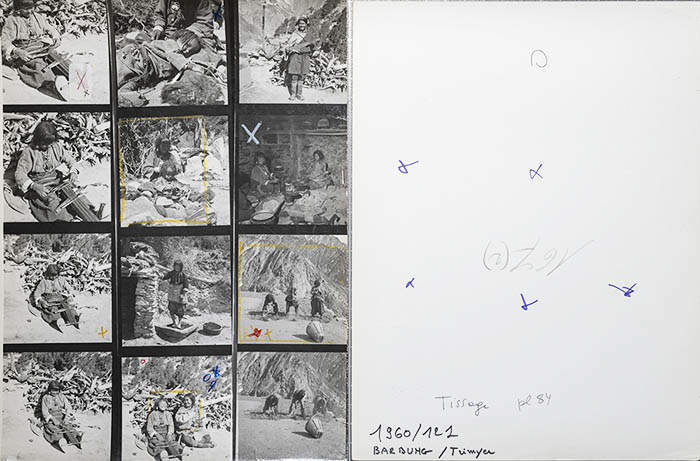
In progress
NOTEBOOKS
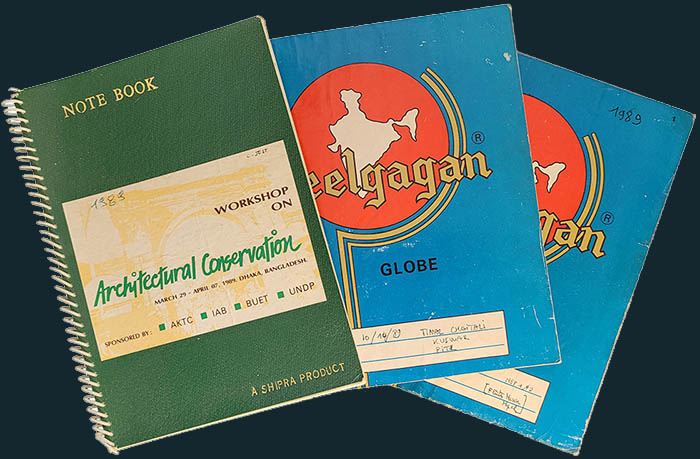
In progress
PUBLICATIONS
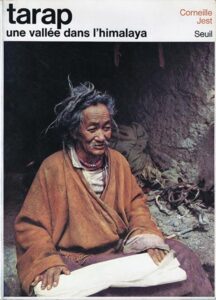
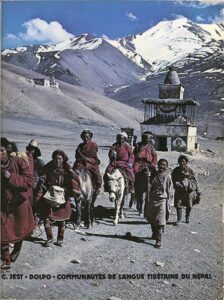
Corneille Jest has authored and collaborated on a large number of scientific publications throughout his career.
An almost exhaustive chronological list is currently available on the NepalPlus Website.
A complete bibliography is currently being compiled and will shortly be published by the Mémoires de l’Himalaya association.
Book selection
- 1974, Tarap : une vallée dans l’Himalaya, Paris, Seuil.
- 1975, Dolpo : communautés de langue tibétaine du Népal, Paris, Éditions du Centre national de la recherche scientifique.
- 1981, Monument du Nord du Népal, UNESCO. (consultable et téléchargeable sur leur site)
- 1985, La Turquoise De Vie : Un Pèlerinage Tibétain, Paris, Anne-Marie Métaillié. (traduction anglaise: 1998, Tales Of The Turquoise: A Pilgrimage in Dolpo, New York, Snow Lion)
AUDIO RECORDINGS
Corneille Jest made a large number of sound recordings during his missions between 1960 and 1993.
Some of the original media were donated by the Centre d’études himalayennes to the Centre de recherche en Ethnomusicologie (LESC-CREM).
The original tapes (1960-1981) and edited discs were digitized by CREM, and these recordings (661 items) are now freely available on the Telemeta platform.
FILMS
In collaboration with Jean-Dominique Lajoux, Corneille Jest has produced 5 films broadcast by CNRS Images.
They are :
Tarap : la vallée aux chevaux excellents (1967, 23 min., French)
Ma-Gcig – la mère : Peinture d’une tan-ka (1970, 20 min., Tibetan)
Description détaillée de la réalisation, au Népal, d’une tan-ka, peinture sur toile représentant Ma-Gcig, divinité dont la vie fut un exemple de foi. Lors d’un rituel pratiqué pendant un jeûne collectif à Dolpo, la biographie de Ma-Gcig est récitée devant la tan-ka sur laquelle les grands événements de sa vie sont montrés aux fidèles. Le lama peintre d’une communauté de Ken dessine et peint, selon des règles très strictes, une tan-ka de Ma-Gcig. Il prépare la toile de coton, qu’il tend sur un cadre de bois, blanchit et fait sécher. Sur la surface poncée il trace les contours du dessin d’après un modèle sur papier, et applique au pinceau les couleurs selon leur valeur symbolique et religieuse.
Seto Matsyendranath (1970, 11 min., French)
Lors de la fête annuelle de Seto Matsyendranath, à Kathmandou, la statue de la divinité est sortie du temple pour être promenée dans les rues des quartiers de la vieille ville. La légende rapporte que ceux qui voient la divinité obtiendront le salut. La statue est d’abord portée dans une châsse par des prêtres bouddhistes jusqu’au char à plusieurs étages somptueusement décoré sur lequel elle est hissée pour être promenée de temple en temple. Une foule très dense de fidèles bouddhistes et hindouistes entoure le char, et participe à la fête. Chacun dépose son offrande, décore le char, implore l’effigie de la divinité Bhairav, une multitude s’attèle pour tirer le char géant. Des musiciens jouent, des jongleurs montrent leurs talents.
La Fête du milieu de l’été (1973, 18 min., French)
Chaque année la communauté tibétaine du village de Tarap au Népal célèbre le Dbyar Ston, cérémonie du milieu de l’été, qui est à la fois une fête religieuse propitiatoire et la fête de la vallée, et dure une quinzaine de jours. En 1967, la cérémonie religieuse se déroule dans le temple de Ri-bo-bum-pa. Les jeunes hommes blanchissent à la chaux les murs extérieurs du temple. Une procession accompagnée de musiciens se rend alors au sanctuaire où, tout au long des journées de cérémonie, des textes religieux sont récités, des offrandes déposées et des prières psalmodiées. Les lamas masqués dansent en cercle, en tournant sur eux-mêmes. La cérémonie se termine par le homa, offrandes au feu.
Spré-lo (1976, 45 min., French)
Dans la haute vallée himalayenne de la Kali Gandaki au Népal, une cérémonie rituelle fait revivre tous les douze ans, l’année du singe, les quatre divinités tutélaires des clans thakali : le monstre marin, la lionne blanche des glaciers, l’éléphant-joyau et le yak produit par lui-même. Les prêtres des divinités, munis de leurs attributs de fête, marchent vers un village de montagne pour rejoindre la divinité du clan batachang, le yak. Les trois autres animaux mythiques, personnifiés par des masques, sont aussi sortis de leur réserve secrète et immergés dans la source sacrée pour être purifiés. Dans une grotte-sanctuaire les prêtres récitent la légende d’origine puis vont chercher les masques dans la source. Le doyen de l’assemblée du village les restaure et les décore longuement. Quelques jours plus tard on construit la représentation des corps des animaux mythiques, sortes de cabanes recouvertes de tissu. Ils sont portés en procession sur un trajet de près de huit kilomètres reconstituant le cheminement mythique. Le dernier jour, les masques sont ramenés dans la grotte.
OBJECTS
During his fieldwork in the Himalayan regions in the 1960s and 1970s, Corneille Jest acquired numerous everyday objects and handicrafts for the Musée de l’Homme (993 items), as well as donating prints of his photographs (1257 items). Some of these documents and those collected by Jacques Millot were presented to the public at the “Nepal, Men and Gods” exhibition held at the Musée de l’Homme from December 1969 to April 1970.


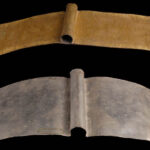
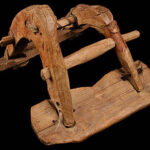
All the documents are now kept at the Musée du Quai Branly – Jacques Chirac and can be consulted on the Museum’s Website.
Corneille Jest also collected a herbarium of almost 240 samples, which has been deposited with the Muséum National d’Histoire Naturelle in Paris.
